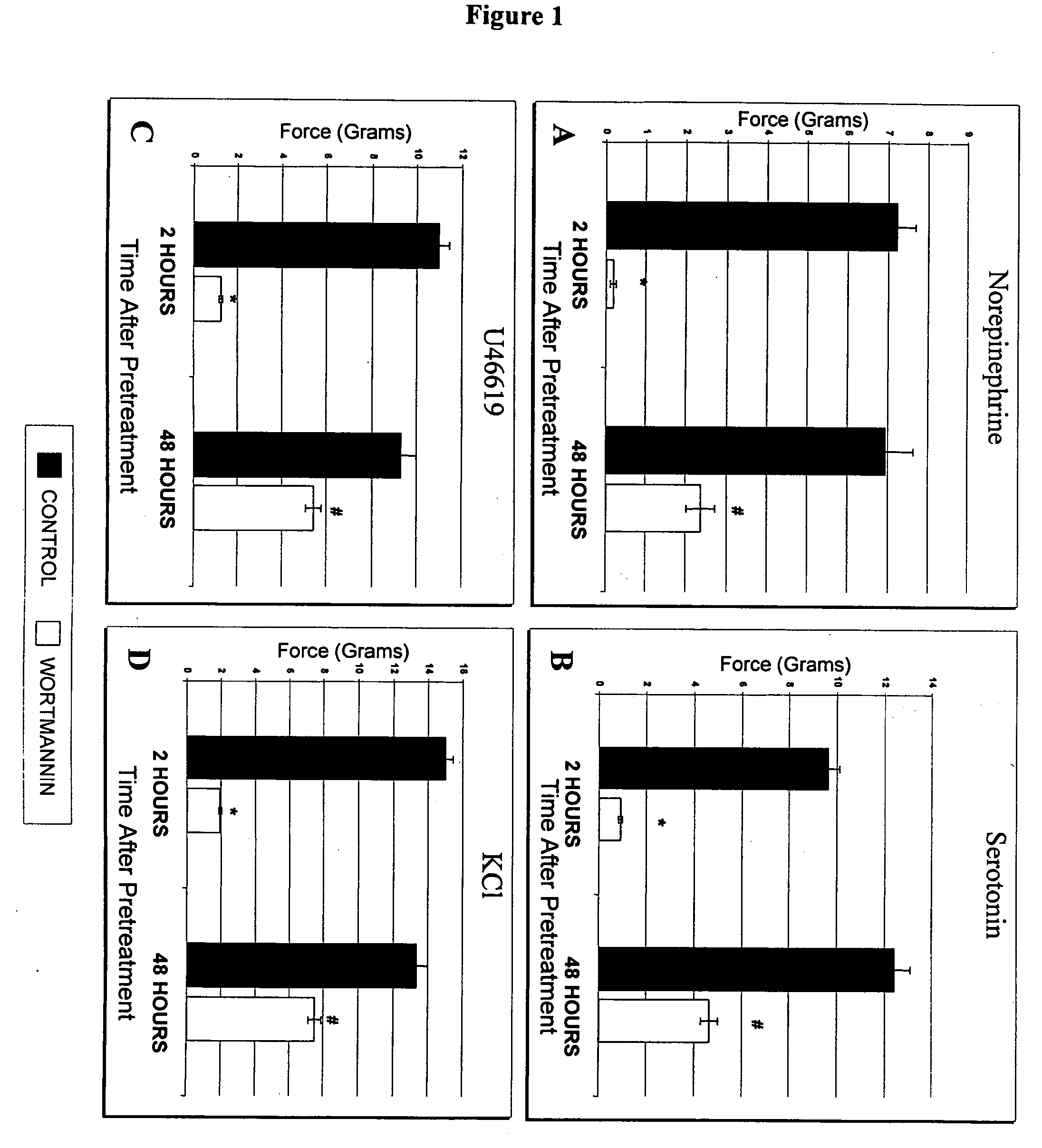Methods and compositions for preventing vasospasm
a vasospasm and composition technology, applied in the field of vasospasm inhibition methods and compositions, can solve the problems of not addressing the redundant extracellular stimuli and intracellular signals, antispasmodic therapies, and early vasospasm of the radial artery when used as a conduit for coronary bypass surgery, and achieve the effects of reducing or preventing vasospasm, promoting myosin light chain phosphorylase activity,
- Summary
- Abstract
- Description
- Claims
- Application Information
AI Technical Summary
Benefits of technology
Problems solved by technology
Method used
Image
Examples
example 1
Inhibition of Vasoconstriction by Blockade of MLCK Activity
[0082] In this example, a myosin light chain kinase inhibiting (MLCK) agent, wortmannin, is used to inhibit or bind to MLCK to attenuate radial artery vasoconstriction up to 48 hours after brief treatment. This strategy may prevent vasospasm of arterial grafts from all causes for several postoperative days.
[0083] Two hours after treatment, WT-treated vessels contracted significantly less than control vessels in response to NE (0.19±0.07 vs. 7.22±0.37 g, P1A-D, n=35 segments from five animals in each group). There was no significant difference in the magnitude of contractile force in control vessels between 2 and 48 h.
example 2
Endothelial-Independent Smooth Muscle Relaxation
[0084] The capacity of the vascular smooth muscle to relax independently of the endothelium was evaluated by pre-constricting vessels with U46, followed by exposure to incrementally increasing concentrations of SNP, a direct smooth muscle relaxing agent. WT-treated vessels were not tested at the 2 h time point since they do not contract sufficiently (maximal contraction=1.25±0.17 g vs. 10.99±0.50 g for controls) in the early period in order to pre-constrict and subsequently relax by SNP; they were, however, tested at the 48 h time point. Two hours after soaking, control vessels relaxed 99.04±7.30% from their pre-constricted state in response to SNP.
[0085] At 48 h, with lower concentrations of SNP L≦0.5 μM), the WT-treated group had a diminished relaxation response compared to controls (76.01±2.60% for WT-treated vs. 87.49±2.91% for controls, P=0.01, FIG. 2).
example 3
Histologic Evaluation of Vessels
[0086] The vessels were tested for microscopic evidence of injury 48 h after treatment and incubation. Control vessels did not show any signs of morphologic damage by hematoxylin and eosin staining in the endothelium or the smooth muscle. In WT-treated vessels, there was minimal hypereosinophilic staining in the smooth muscle, possibly representing mild hypoxic changes. There was no necrotic debris, loss of nuclei or loss of structure visualized. The endothelium and elastic lamina of WT-treated vessels appeared normal.
PUM
| Property | Measurement | Unit |
|---|---|---|
| time | aaaaa | aaaaa |
| time | aaaaa | aaaaa |
| pH | aaaaa | aaaaa |
Abstract
Description
Claims
Application Information
 Login to View More
Login to View More - R&D
- Intellectual Property
- Life Sciences
- Materials
- Tech Scout
- Unparalleled Data Quality
- Higher Quality Content
- 60% Fewer Hallucinations
Browse by: Latest US Patents, China's latest patents, Technical Efficacy Thesaurus, Application Domain, Technology Topic, Popular Technical Reports.
© 2025 PatSnap. All rights reserved.Legal|Privacy policy|Modern Slavery Act Transparency Statement|Sitemap|About US| Contact US: help@patsnap.com



